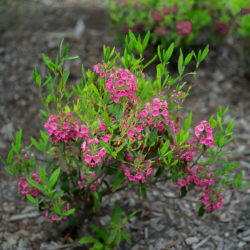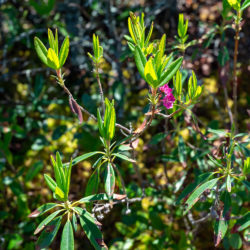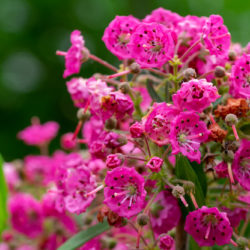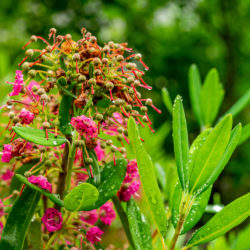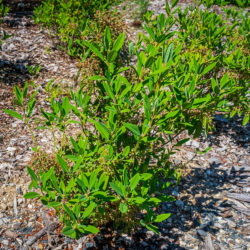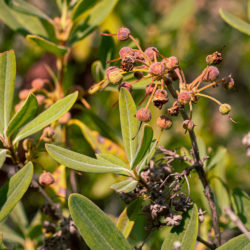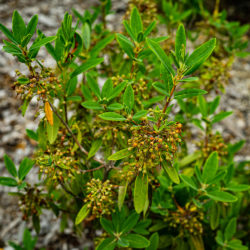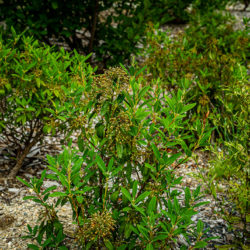Etymology
Kalmia is from Latin, honoring Peter Kalm, a botanist, student of Linnaeus, and collector of North American plants in the 1700s; angustifolia is Latin for narrow-leafed.
Native Habitat
Wet pastures, swamps, bog borders, and wooded stream edges throughout northeastern North America.
Garden Uses
Meadow or rain gardens, understory for wet or dry woodland edging, moist depressions. Keep away from domesticated animals.
Overview
This small evergreen shrub grows 3 feet in height by up to 6 feet in width individually, but can spread via dense networks of rhizomes to form large, continuous stands. This species prefers moist, acid soil and part-shade. It can adapt to dry areas, including rocky barrens. Its roots exude chemicals that impede competitors, including many conifers. Its flower growth pattern, beneath the leaf nodes along and around the stems, differentiates it from other laurels that bloom at stem tips.
Leaves and Stems
Simple, smooth, evergreen, narrowly elliptical leaves are bluish green above, pale below in summer, turning to reddish or purple through autumn. The upper surface of the leaf can be hairy. Leaves grow nearly opposite, 2 or 3 per node along and around the stems, and typically measure up to 2 inches each in length. The stems have thin, smooth brown bark, which can be hairy at the tips. Stems tend to trail on the ground, with more erect branch tips. In winter, buds are stalkless, with 2 scales that meet.
Flowers
Deep pink to red or purple, saucer-like flowers, with fused carpals individually 1/2 inch in diameter, bloom in June through July. They form clusters below newly emerging leaves for the season, uniquely along and around the stems.
Fruit/Seed
Dry capsules split to release tiny brown seeds. These capsules may remain on branches for years.
Animal Associates
Poisonous to humans and many types of domestic livestock, but not to deer or winter-feeding birds like grouse. Attractive to butterflies and bees. Larval host to several butterflies, including the Northern Blue (Plebejus idas).
Propagation
Tap root makes transplanting difficult. Can be propagated by seed; seeds are very tiny and mature very late in the autumn. Seeds germinate at 75 degrees F.
Ethnobotanical Uses
All parts of this plant, and honey from it, are toxic to humans, sheep, and domestic cattle.
Garden Location
Library Garden (see garden map)
Sources
Native Plant Network: reforestation, nurseries, and genetic resources. Propagation protocol
Plant Profile by Kate O’Dell

